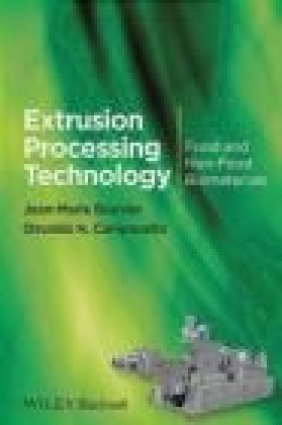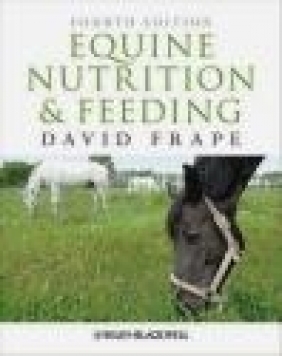Extrusion Processing Technology - Food and Non-Food Biomaterials
Jean-Marie Bouvier, Osvaldo H. Campanella, J. M. Bouvier
Extrusion Processing Technology - Food and Non-Food Biomaterials
Jean-Marie Bouvier, Osvaldo H. Campanella, J. M. Bouvier
- Producent: Blackwell Science
- Rok produkcji: 2014
- ISBN: 9781444338119
- Ilość stron: 530
- Oprawa: Twarda
Niedostępna
Opis: Extrusion Processing Technology - Food and Non-Food Biomaterials - Jean-Marie Bouvier, Osvaldo H. Campanella, J. M. Bouvier
The only up-to-date book on this important technology, Extrusion Processing Technology: Food and Non-Food Biomaterials bridges the gap between the principles of extrusion science and the practical "know how" of operational engineers and technicians. Written by internationally renowned experts with over forty years of experience between them, this valuable reference for food scientists, food engineers, chemical engineers, and students includes coverage of new, greener technologies as well as case studies to illustrate the practical, real-world application of the principles in various settings.Foreword ix Acknowledgements xi 1 Generic Extrusion Processes 1 1.1 A history of extrusion processing technology 1 1.1.1 The introduction of screw extruders 1 1.1.2 The generic extrusion process concept 2 1.1.3 Extrusion technology in the polymer-processing industry 3 1.1.4 Extrusion technology in the food- and feed-processing industry 4 1.1.5 Extrusion technology in the paper-milling industry 8 1.2 Factors driving the development of extrusion processing technology 9 1.2.1 Process productivity 9 1.2.2 Product innovation and functionality 9 1.2.3 Environmentally friendly processing 10 1.3 The industrial and economic importance of extrusion processing technology 10 1.3.1 In the polymer and plastics industry 10 1.3.2 In the food and feed industry 10 1.3.3 In the paper milling industry 11 1.4 Contents and structure of the book 11 References 12 2 Extrusion Equipment 13 2.1 Extruders 13 2.1.1 The kinematics of extruders 13 2.1.2 The screw-barrel assembly 15 2.1.3 The die assembly 20 2.1.4 The central operating cabinet 28 2.2 Extruder screw-barrel configurations 28 2.2.1 Single screw extruders 29 2.2.2 Intermeshing co-rotating twin screw extruders 31 2.2.3 Screw-barrel configuration and wear 33 2.3 Ancillary equipment 39 2.3.1 Upstream ancillary equipment 40 2.3.2 On-line ancillary equipment 44 2.3.3 Downstream ancillary equipment 46 References 51 3 Extrusion Engineering 53 3.1 Thermomechanical processing in screw extruders 53 3.1.1 Process configuration of single screw extruders 53 3.1.2 Process configuration of intermeshing co-rotating twin screw extruders 55 3.1.3 Processing specificities 56 3.2 Thermomechanical flow in screw extruders 58 3.2.1 Modeling approaches 58 3.2.2 Solids conveying section 67 3.2.3 Melt conveying section 72 3.2.4 Single screw extrusion versus twin screw extrusion 110 3.3 Thermomechanical extrusion processing: use of numerical methods 115 3.3.1 Single screw extrusion 115 3.3.2 Twin screw extrusion 118 3.3.3 Commercial software 120 References 122 4 The Generic Extrusion Process I: Thermomechanical Plasticating of Polymers and Polymer Melt Forming 125 4.1 The bio-based polymers and bio-based plastics 126 4.1.1 Definitions 126 4.1.2 Macromolecular characteristics of bio-based polymers 129 4.2 Melting mechanism of polymer materials in screw extruders 138 4.2.1 Melting mechanism in single screw extruders: qualitative description 139 4.2.2 Engineering analysis of polymer melting in single screw extruders 140 4.2.3 Melting mechanism in intermeshing co-rotating twin screw extruders 143 4.2.4 Polymer melting: single screw extrusion versus twin screw extrusion 146 4.3 Physical transitions of bio-based polymers 147 4.3.1 Physical transitions of polymeric materials: generalities 147 4.3.2 Glass and melting transitions: basics 149 4.3.3 Glass and melting transitions of bio-based polymers 151 4.4 Flow properties of bio-based polymer melts 157 4.4.1 Flow behavior: basics 157 4.4.2 Measurement of flow properties of polymer melts 159 4.4.3 Rheological characteristics of bio-based polymer melts 161 4.5 Case studies: emerging applications 162 4.5.1 Melting of polyamide-11 in a single screw extruder: exercise 162 4.5.2 Extrusion processing of biodegradable starch-based loose-fill packaging foams 163 4.5.3 Extrusion compounding of flax fiber-reinforced thermoplastics 165 References 168 5 The Generic Extrusion Process II: Thermomechanical Micromixing and Reactive Extrusion 173 5.1 Reactive extrusion: qualitative description 174 5.1.1 Bulk polymerization 174 5.1.2 Reactive processing of polymers. Reactive plastics reprocessing 175 5.1.3 Reactive extrusion in classic organic chemistry 177 5.1.4 Reactive solid-liquid extrusion-pressing 178 5.1.5 Processing characteristics of reactive extrusion 178 5.2 Reactive extrusion: chemical reaction engineering approach 179 5.2.1 The continuous plug flow reactor 181 5.2.2 Mixing in screw extruder-reactors 189 5.2.3 Heat transfer mechanisms in extruder-reactors 206 5.2.4 Coupling of transport phenomena and chemical reactions 210 5.2.5 Basic principles of process engineering in reactive extrusion 213 5.3 Reactive extrusion applications and processing lines 215 5.3.1 The classes of chemical reactions in reactive extrusion 215 5.3.2 Case study 1: casein-to-caseinate extrusion processing 217 5.3.3 Case study 2: extrusion pulping of non-wood fibers 220 5.3.4 Case study 3: enzymatic hydrolysis of starch 225 References 238 6 The Generic Extrusion Process III: Thermomechanical Cooking and Food Product Texturization 243 6.1 Food extrusion-cooking: qualitative description 244 6.1.1 Thermomechanical cooking of biopolymer-based systems 244 6.1.2 Texturization of extrusion-cooked melts 254 6.2 Engineering analysis of process functions 255 6.2.1 Preconditioning 255 6.2.2 Extrusion-cooking 261 6.2.3 Steam-induced die texturization 276 6.3 Examples of industrial applications: food extrusion processing lines 293 6.3.1 Breakfast cereals extrusion processing 294 6.3.2 Aquafeed extrusion-cooking process 300 6.3.3 High-moisture extrusion-cooking process 304 References 306 7 Quality Analysis of Extrusion-Textured Food Products 311 7.1 Methods of thermomechanical cooking analysis 311 7.1.1 Optical microscopy for birefringence analysis 312 7.1.2 Water solubility (WSI) and absorption (WAI) indices 312 7.1.3 Alkaline viscosity 313 7.1.4 Differential scanning calorimetry 313 7.1.5 Rapid Visco(t); Analyzer 314 7.2 Methods of characterizing extrudate texture 327 7.2.1 Measurement of product density 327 7.2.2 Measurement of structural characteristics 328 7.2.3 Measurement of mechanical characteristics 334 7.2.4 Physical texture of directly expanded extrudates 342 7.3 Case study: texture monitoring of directly expanded extrudates 343 7.3.1 Main features of process--product relationships 343 7.3.2 Methodology for texture monitoring 344 7.3.3 Master correlations between sensory attributes and puncture parameter 346 References 348 8 The Generic Extrusion Process IV: Thermomechanical Pretreatment and Solid--Liquid Separation 351 8.1 The fourth Generic Extrusion Process: continuous mechanical expression 352 8.2 Engineering analysis of thermomechanical expression 356 8.2.1 Structure of cellular biological materials 357 8.2.2 Introduction of the nomenclature 359 8.2.3 General description of the filtration and consolidation processes 363 8.2.4 Rheological properties of cellular biological materials and their characterization 367 8.3 Process modeling 370 8.3.1 The fluid mechanics of the process and determination of relevant parameters 370 8.3.2 Effects of material properties on the process yield 375 8.3.3 Effects of processing conditions and screw geometry on pressure build-up and liquid expression 378 8.4 Case studies: examples of industrial applications 381 8.4.1 Continuous screw extrusion-pressing of copra, a hard cellular material 382 8.4.2 Continuous screw extrusion-pressing of groundnuts/peanuts, a soft cellular material 382 8.4.3 Soybean processing 383 8.4.4 Feed pretreatments 386 References 390 9 The Generic Extrusion Process V: Thermophysical Micromixing and Material Porosification 393 9.1 The new generic extrusion-porosification process 395 9.1.1 Typical drying processes for instant powders 395 9.1.2 Main drivers of instant powder drying 417 9.1.3 The extrusion-porosification process 421 9.2 Engineering discussion of process functions 425 9.2.1 Vacuum evaporation 426 9.2.2 Twin screw extrusion-aeration 440 9.2.3 Intensified spray drying 450 9.3 Perspectives on industrial applications 451 9.3.1 Range of applications 451 9.3.2 Case study: extrusion-porosification of dairy products 453 References 459 10 Extrusion Technology and Process Intensification 465 10.1 From sustainable development to process intensification 465 10.1.1 The IPAT equation 466 10.1.2 Sustainable development 467 10.1.3 Sustainable technology 469 10.1.4 Concept of process intensification 470 10.2 Process intensification in extrusion processing technology 472 10.2.1 Characteristic times of process phenomena 473 10.2.2 Process-intensifying methods in extrusion 474 10.2.3 Sustainability of extrusion processing technology 497 10.3 Case studies: exercises 499 10.3.1 Exercise 1: Residence time distribution 499 10.3.2 Exercise 2: Polymer melt coupling in reactive extrusion 501 10.3.3 Exercise 3: Weighted average total strain 502 10.3.4 Exercise 4: Energy saving in extrusion-cooking 503 10.3.5 Exercise 5: Water saving in solid-liquid extrusion-pressing 503 10.4 Conclusion: future trends 504 References 505 Index 507
Szczegóły: Extrusion Processing Technology - Food and Non-Food Biomaterials - Jean-Marie Bouvier, Osvaldo H. Campanella, J. M. Bouvier
Tytuł: Extrusion Processing Technology - Food and Non-Food Biomaterials
Autor: Jean-Marie Bouvier, Osvaldo H. Campanella, J. M. Bouvier
Producent: Blackwell Science
ISBN: 9781444338119
Rok produkcji: 2014
Ilość stron: 530
Oprawa: Twarda
Waga: 1.22 kg


























